Pasta Primavera
Published Apr 21, 2025
This Pasta Primavera is all about fresh vegetables and lemon in a creamy sauce tossed with al dente penne pasta.
This post may contain affiliate links. Please read our disclosure policy.
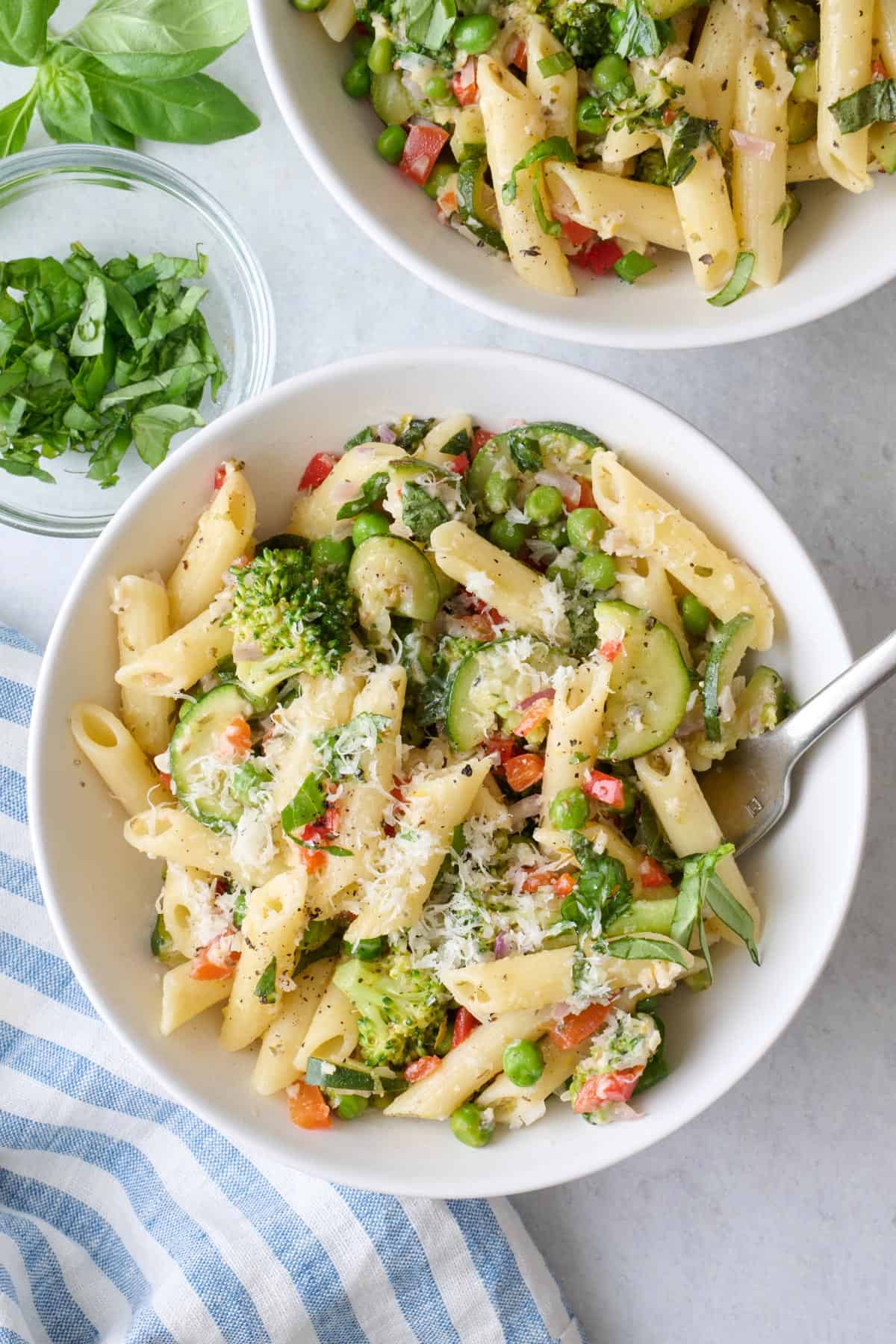
Jump to Section
Pasta Primavera Please!

Pasta primavera is made with lots of colorful vegetables in a light, creamy sauce. The name means “spring pasta” in Italian and I love the idea of welcoming spring with a pasta dish that’s full of colorful, vegetables. And it’s not just for spring. This is a great way to load up your pasta with fiber-rich vegetables, and I’m here for it!
You can check out my tips for how to blanch vegetables which is the authentic way of making pasta primavera, but I prefer to just heat the vegetables in a large skillet and then toss them with the pasta and the sauce without getting one more pot dirty. Keep this recipe in your back-pocket as a way to use up leftover vegetables at the end of the week or to sneak in those vegetables for your family. My daughter picks out the onions and my son picks out the peas, but I know they each missed a few (haha!) and that’s good progress!

Pasta Primavera Ingredients

- Pasta: I like use use penne, but any pasta shape will work!
- Olive oil: Or any neutral oil like avocado oil.
- Vegetables: Broccoli, red onion, red pepper, zucchini, and peas are my go-to’s (and I know my kids like most of them!), but you can use more or less of any of them.
- Spices: I keep the spices simple with minced garlic, salt, pepper, and Italian seasoning!
- Milk: Whole milk adds the best flavor, but for something even richer you could use heavy cream.
- Lemon: Zest the lemon first, then juice it!
- Parmesan: If you’re vegetarian, make sure you get rennet-free Parmesan cheese.
- Basil: Fresh basil is the move here. Dried basil just won’t have the same flavor!
Popular Additions
- More vegetables. I know there are already a ton of vegetables in this pasta, but you could always add a few handfuls of spinach of chopped kale. Sliced asparagus would also be great!
- Add tomatoes. I sometimes include halved cherry or grape tomatoes (usually a cup or two) in the vegetable mixture.
- Add some heat. If I’m making this just for myself or my husband, I’ll add a little red pepper flake.
- Add protein. Mix in sliced or shredded rotisserie or roasted chicken, adding as little or much as you’d like!
How to Make Pasta Primavera



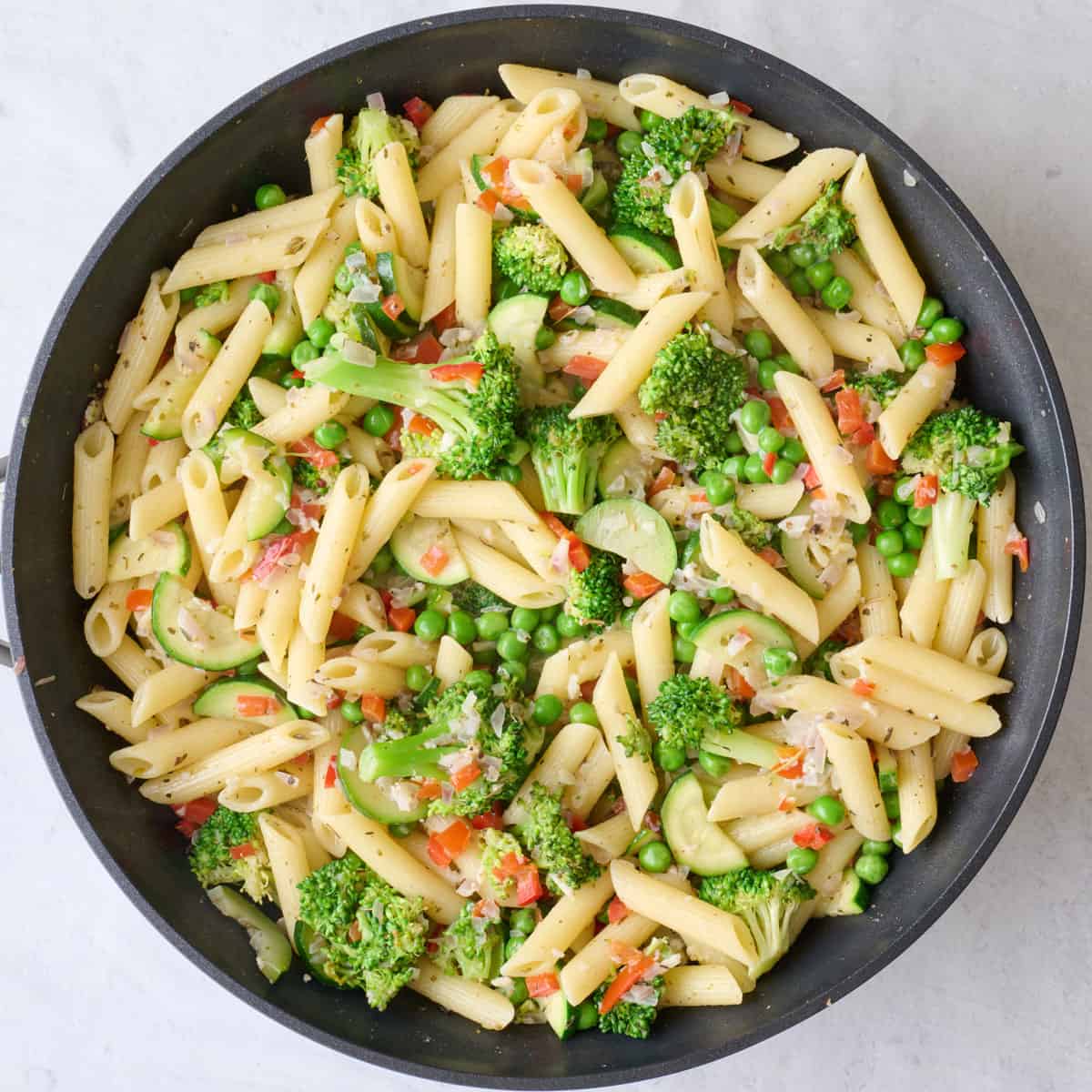
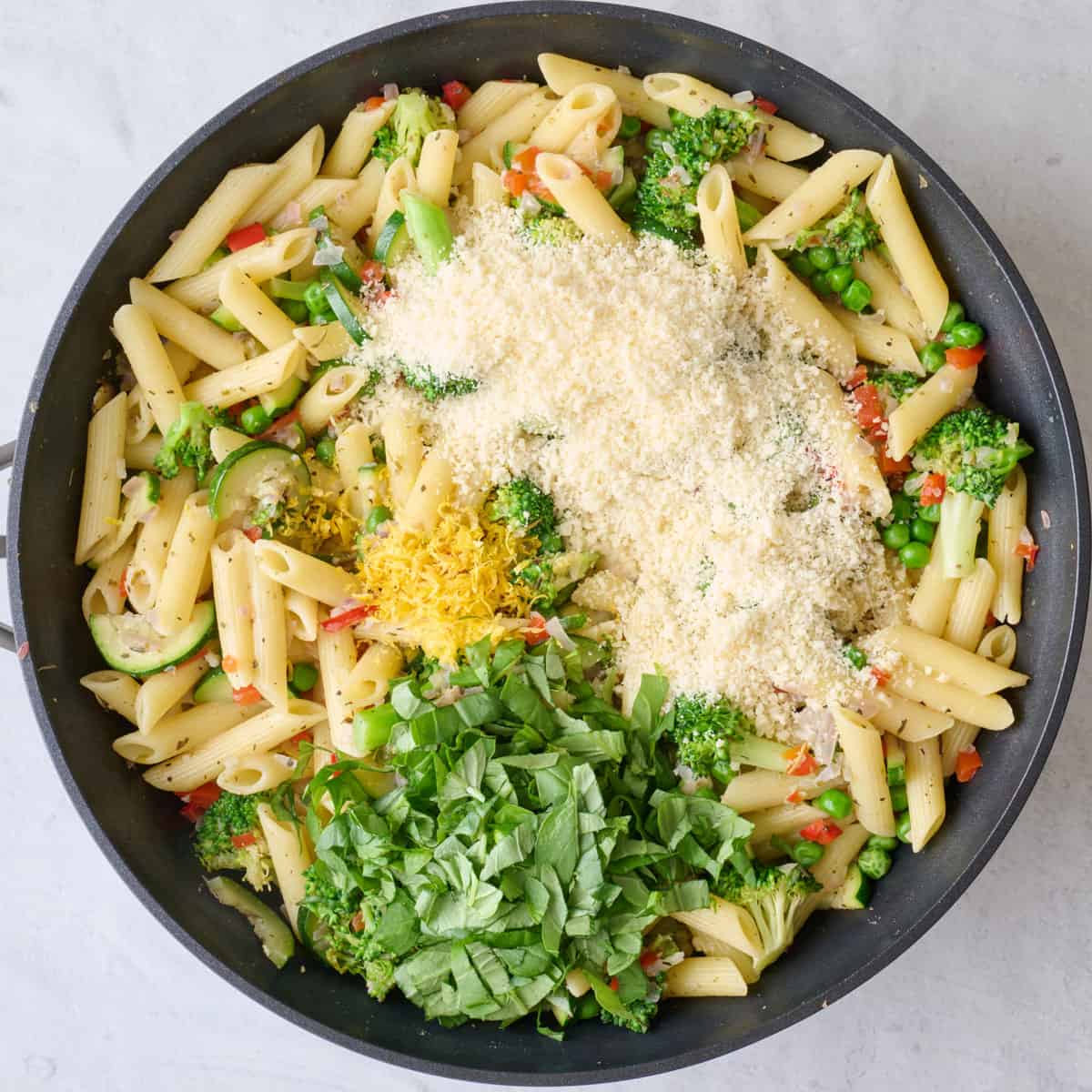

My Best Pasta Primavera Tips
- Make sure to salt the pasta water. I’ve heard that pasta water should be as salty as the sea! Because pasta absorbs water as it cooks, the salted water adds a lot of flavor.
- Don’t toss the pasta water. Before you drain the pasta, set some of the cooking liquid aside. This water is starchy from the pasta and will help thicken the pasta sauce!
- Taste the pasta early. For al dente pasta that’s chewy yet soft, I start tasting it a minute or two before the package instructions say it’ll be done.
- Cook the vegetables as much as you’d like. I like when the vegetables still have some bite to them, so I only cook them until they just start to soften in this recipe! That said, you can absolutely cook them longer if you want them softer.
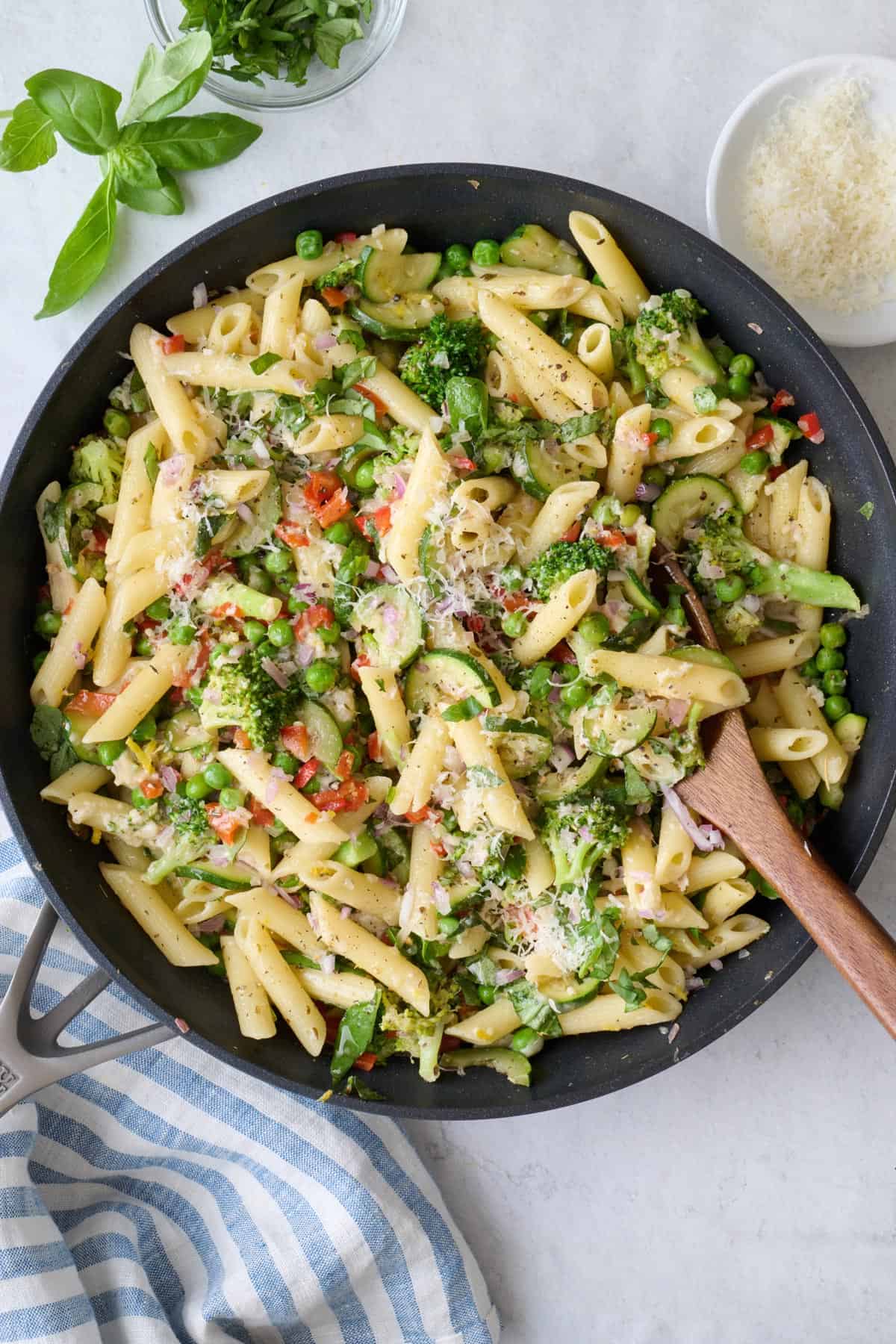
Serving Ideas
Recipe Help & FAQs
Kept in an airtight container in the fridge, the pasta will last for up to 3 days. I recommend heating up individual portions in the microwave for a few minutes! If you want to heat it up on the stovetop, you might want to add a little water to help loosen the sauce.
I would just add a little water or more milk as needed to help the sauce coat the pasta!
There’s really no right answer for this! You can use penne, spaghetti, fusilli, orecchiette, bucatini—really, whatever you like.

More Vegetarian Pasta Recipes:
- Pistachio Pasta
- Creamy Lemon Ricotta Pasta
- Cauliflower Alfredo
- Roasted Beet and Parmesan Pasta
- Easy Baked Spaghetti
- Spinach Lasagna Roll Ups
- Creamy Cashew Tomato Pasta
If you try this Pasta Primavera recipe or any other recipe on Feel Good Foodie, then don’t forget to rate the recipe and leave a comment below! It helps others who are thinking of making the recipe. I would love to hear about your experience making it. And if you snapped some shots, share it on Instagram so we can repost on Stories!
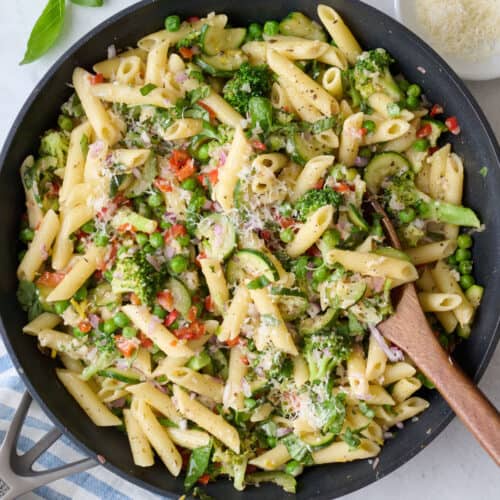
Pasta Primavera Recipe
Ingredients
- 1 pound penne pasta or pasta of choice
- 2 tablespoons olive oil
- 2 cups small broccoli florets
- 1 small red onion sliced
- 1 red pepper sliced
- 1 zucchini halved and sliced
- 3 garlic cloves minced
- 1 tablespoon Italian seasoning
- 1 teaspoon salt plus more for salting the pasta
- ½ teaspoon black pepper
- 1 cup frozen peas thawed
- ½ cup whole milk
- 1 small lemon zest and juice
- ½ cup grated Parmesan cheese plus more for serving
- ¼ cup chopped basil plus more for serving
Instructions
- In a large pot of boiling salted water, cook the pasta according to package instructions; drain well and reserve 1 cup of pasta water and return to the pot to keep warm.
- Meanwhile, in a large deep skillet, heat the olive oil over medium heat. Add the broccoli, red onions, red pepper, zucchini, and garlic. Season with Italian seasoning, salt, and pepper. Cook for about 4 minutes, or until the vegetables start to soften.
- Add the cooked pasta, peas, milk, and the reserved pasta water and stir to combine until the sauce thickens and clings to the pasta, about 1-2 minutes.
- Remove from heat and stir in lemon zest, lemon juice, Parmesan cheese, and basil.
- Serve in bowls garnished with extra parmesan cheese and basil, if desired.
Notes
Nutrition
Nutrition information provided is an estimate. It will vary based on cooking method and specific ingredients used.





